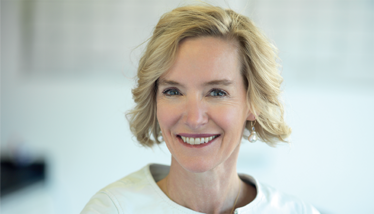The Journey of Founding a Company
Lessons learned in starting up a company – and navigating an industry dominated by men
Stacy Blain | | 8 min read | Career

I can’t remember a time when I didn’t want to be a scientist, and as a kid, I always imagined that I would have a lab in the back of my house. I was the kid who took the frog home at the end of the summer to continue dissecting it, irradiated fruitflys in the back of the classroom to see if I could change eye color in future generations, and built a model of the human body complete with veins and arteries. I wanted to know how things worked, so I asked a lot of questions.
My grandfather gave me a biography about Marie Curie when I was 7 years old. No one in my immediate family was a doctor or scientist, but I was fortunate to have exceptional science teachers from my earliest days. Ms. Hartsook was my first-grade science teacher, and she started me on this path. Dr. Crabtree, my high school science teacher – and the first person I met with a PhD – opened new aspirations for me. Before our introduction, I had only considered going to med school to do research. In high school, I realized I could get a PhD and do experiments all the time, and I went to Princeton because they had just opened a molecular biology department, distinct from the traditional evolution, ecology, and behaviour disciplines.
Concarlo’s origins
After my PhD at Columbia, I went to Memorial Sloan-Kettering Cancer Center to finish my training, and worked in the lab of Dr. Joan Massague. Along with Drs Andrew Koff and Jim Roberts, he had just discovered this new protein, p27, and I essentially took up the mantle to continue working on this protein to figure out how it functioned. I have continued working on this protein for the last 25 years and I became a faculty member at one of the state universities of New York. From the beginning, we had envisioned that if we could figure out how p27 regulated the kinases CDK2/4/6, we could harness that power to turn these kinases off in cancer. We sorted that out around 2013, and I started Concarlo in 2017. But while my entire career was probably headed towards the development of p27-targeting drugs, I hadn’t focused on starting a company; I simply wanted to understand how p27 worked and how we could leverage its regulatory power.
A few things happened that really pushed me to start Concarlo Therapeutics and as a scientist, I was able to see that these forces were leading me in one direction. First, I submitted a large RO1 grant from my academic lab to the NIH in 2015, which was not funded. When I spoke to my program officer, he said that it was a great grant, but it was clear that I wanted to make a drug, which is something academics can’t do. He suggested that I start a company, and get an SBIR grant to fund that work, and I applied to the NYC economic development corporation to get help with this.
Second, the tech transfer office at my university took me to a few meetings to meet with venture capitalists. I naively thought they would just fund my lab so I could continue studying the target and develop the drug. When they said that the tech was still too immature for their investment, they suggested that I start a company instead. I didn’t know anything about the business of running a company, but I knew that I needed to find people that did and I found two co-founders. One was a 20-year veteran in the financial industry, who had decades of experience running and founding companies, and (importantly) raising money. The second was a fractional COO, who had started and operated companies for decades, albeit in a different industry. My university had an incubator on campus, and a recent graduate student from my lab joined. And so we began Concarlo.
Combatting cancer
Cancer is caused by uncontrolled cellular proliferation. The signals that normally regulate this process are controlled by a family of three kinases: CDK2, CDK4 and CDK6. In cancer, these kinases push the cancer cell into the proliferative phase. One of the goals in oncology for decades has been to turn these kinases off, but it is difficult because these three kinases look very similar to a large family of kinases. Most of the biotech industry’s attempts to drug these three specifically have met with unacceptable levels of toxicity, by inhibiting targets in non-tumor cells or inhibiting the wrong target completely. Only CDK4/6 inhibitors have been approved by the FDA, but drug resistance is a common problem.
p27 is the master regulator that normally controls all three kinases, acting as a switch to turn them on and off. We believe that targeting p27 can help us to fight resistance, by inhibiting all three targets simultaneously, not leaving room for resistance to develop. p27 is not a traditional drug target because it is not a kinase nor a cell surface receptor, making it difficult to drug by small molecule kinase inhibitors or monoclonal antibodies. However, we followed nature’s lead and co-opted the endogenous p27 inhibitor. Nature had already performed thousands of years of high throughput screening to find the best way to inhibit p27, forcing it to inhibit CDK2 and CDK4/6.
Concarlo is developing medicines that will convert p27 into its inhibitor mode to turn these three kinases off. Our approach will specifically inhibit only CDK2 and CDK4/6, producing a therapy with low toxicity. Since p27 targeting inhibits all three kinases, it will work in drug-resistant cells as well as treatment naïve cells. We have validated the p27 target as a way to inhibit CDK2 and CDK4/6 in numerous tumor types and animal models. We have developed our lead product, completed preliminary CMC, have assembled an amazing team and are ready to move this lead asset to the clinic in less than 2 years.
Our initial focus is metastatic, Ibrance-resistant breast cancer, but we will move on to other cancers driven by CDK2 (those that are a priori resistant to CDK4/6 inhibitors), such as ovarian. We will also look at cancers that involve mutations in the RAS/MAPK pathway, such as non-small lung cancer or melanoma.
The challenges of building a business
In 2017, there was little support for academics for start-up companies. In fact, most of my colleagues wondered why I was doing this. For me, however, staring Concarlo Therapeutics was the logical next step – both in my research and my personal evolution as a scientist.
If I had been in Boston or San Diego, it might have been easier, but New York was a very juvenile biotech ecosystem, with limited support. Today, New York is much more mature, with numerous incubators and accelerator programs, so I think the transition would be easier today, but academics will always face challenges. Academics do not have a rolodex filled with venture capitalists, so getting intros and raising money is difficult. Venture funds like to fund serial entrepreneurs or people they have backed in the past, which makes it difficult for anyone new to break into this funding space. p27 was a new target and our approach using a peptide was less traditional, so we had to do a lot of convincing.
Studies have shown that women-lead companies yield better returns on investment, but women-led companies only receive ~2 percent of venture funding. Those two stats seem incongruous and might discourage women to start companies. Honestly, the latter would have discouraged me if I had known that! As a female CEO, I have a depressingly low chance of raising funding for my company. But that has to change, and women need to continue to put themselves and their technologies out there. Find an accelerator or mentorship program to build a network of other women in the industry. Representation matters and learning from the talented women who have gone before will help during this journey.
Women in STEM
STEM is still a male dominated field, although this is hopefully beginning to change. There are more male faculty members in academia, more male members of pharma C-suites, and more male board members. However, we graduate nearly equal numbers of women and men with science PhDs, raising the question of where these talented and interested women go. I think we need to really figure out what the discouraging factors, policies, or systems are that make it difficult for women to stay in these industries.
Even for women like me – that have chosen to continue in this field, bias (both conscious and unconscious) – exists, and I have faced unnecessary obstacles during my path. For example, studies have shown that women that speak with more passive language tend to fare better in the workplace, get bigger promotions, and receive more funding and advancement, compared to those that speak confidently and with conviction (1). So to be successful, women tend to keep their mouths shut, making it difficult for bold women to gain tenure, move into C-suites, and on to boards.
Women and men enter science careers because they want to solve problems and be a part of solutions. My advice to women starting out is to follow your passion without going into this field blindly. Recognize that this is still a male dominated profession and be on the lookout for bias and obstacles. Find mentors that are familiar with the challenges associated with being a woman in a male-dominated profession. Make sure that you work in an environment where women are respected, promoted, valued, and encouraged. If you find yourself disrespected, speak up. This can be difficult as a junior person starting out, but if you don’t stop that or call out the behavior at the outset, it will not disappear. You need to make sure that your gender does not become an obstacle.
- The New York Times, “Women Know Exactly What They’re Doing When They Use Weak Language,” (2023). Available here
Co-Founder and Chief Scientific Officer of Concarlo Therapeutics



















